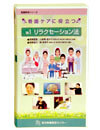|
|
|
|
• NK-01 Relaxation Method |
|
 |
|
 |
 |
Need for instruction of relaxation method has come to arise among the scenes of nursing-care. This is because there are situations where patients see tension typical of clinical scenes while in hospital.
It is essential for caregivers to understand relaxation method and to be able to practice it so that they can give instructions to their patients on how to practice and that the practice can much beneficial to patients.
Why is relaxation method needed now? For understanding relaxation method, this program introduces basic theories of relaxation method (homeostatic mechanism, autonomic nervous system activity, and mind-body correlation theory) and 6 basic methods (breathing, muscular relaxation, imagery technique, autogenic training, biofeedback method, and meditation) using CG. Focused on breathing method and gradual muscular relaxation method as an actual practice, explains the remarks for circumstances and clothes, points of the practices. Contents covered are helpful for understanding and practicing these methods.
|
 |
|
|
|
■ Planned and supervised by Kikuyo Koitabashi, M.A. (professor, School of Health Science of Gunma University)
■ Plan Cooperated by Natsuko Yanagi, M.N. (lecturer, School of Health Science of Gunma University) |
|
|
|
|
|
|
|
|
|
|
|
 |
|
|
|
|
|
|
|
|
|
• NK-02 Finger-pressure Treatment / Massage |
|
 |
|
 |
 |
Since ancient times, care-giving means treatment by hand touching on others to heal them, and therefore, it has been used as a primary method of nursing-care. While medical technology has advanced, now we see finger-pressure treatment/massage are gathering a lot of attention on its needs and usefulness. Effective use of the hands of caregivers allows them to practice care in a multiple manner in a short time, which is expected to be helpful in reducing pain and symptom of patients.
Using CG and live-action film, easily explains the primary theories of finger-pressure treatment/massage such as mechanisms of finger-pressure treatment/massage, action and adaptation, and meridian theory and meridian point. Furthermore, demonstrates actual practices of finger-pressure treatment/massage to show basic techniques and principles of how to press. 6 scenes to provide primary daily care are addressed as seen in morning care, feeding care, urinary elimination care, cleanliness care, positioning, and evening care. Each scene of them is easily explained with demonstration of practicing points and keys of practicing. |
|
|
|
|
|
|
|
|
|
|
|
|
|
■ Planned and supervised by Kikuyo Koitabashi, M.A. (professor, School of Health Science of Gunma University/ representative, Society for the study of finger-pressure massage)
■ Planned by Society for the study of finger-pressure massage
■ Technically advised by Kakuko Kawachi (director, She’s---Acupuncture for Ladies Clinic) |
|
| |
|
|
|
|
|
|



